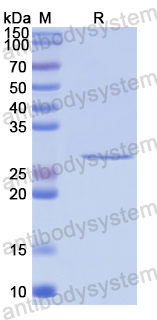Catalog No.
YHG58801
Expression system
E. coli
Species
Homo sapiens (Human)
Protein length
Met242-Thr468
Predicted molecular weight
28.28 kDa
Nature
Recombinant
Endotoxin level
Please contact with the lab for this information.
Purity
>90% as determined by SDS-PAGE.
Accession
Q13563
Applications
ELISA, Immunogen, SDS-PAGE, WB, Bioactivity testing in progress
Form
Lyophilized
Storage buffer
Lyophilized from a solution in PBS pH 7.4, 0.02% NLS, 1mM EDTA, 4% Trehalose, 1% Mannitol.
Reconstitution
Reconstitute in sterile water for a stock solution. A copy of datasheet will be provided with the products, please refer to it for details.
Shipping
In general, proteins are provided as lyophilized powder/frozen liquid. They are shipped out with dry ice/blue ice unless customers require otherwise.
Stability and Storage
Use a manual defrost freezer and avoid repeated freeze thaw cycles. Store at 2 to 8°C for frequent use. Store at -20 to -80°C for twelve months from the date of receipt.
Alternative Names
Autosomal dominant polycystic kidney disease type II protein, TRPP2, PC2, Polycystwin, Transient receptor potential cation channel subfamily P member 2, Polycystin-2, PKD2, Polycystic kidney disease 2 protein, R48321
Ciliary G-Protein Coupled Receptor Signaling in Polycystic Kidney Disease., PMID:40507782
Pathogenic variants in the polycystin pore helix cause distinct forms of channel dysfunction., PMID:40504156
Kidney cystogenesis in embryonic- and adult-onset ADPKD is suppressed from lack of adenylyl cyclase targeting to cilia., PMID:40501923
Targeting interleukin-1 signaling for renoprotection., PMID:40486517
Polycystin-1 acts as an atypical adhesion GPCR that responds to novel Wnt signaling and mechanical stimuli., PMID:40475421
ANKHD1 promotes pathogenic proliferation in Autosomal Dominant Polycystic Kidney Disease via the Cyclin D1/CDK4 pathway., PMID:40457431
Macrophage Accumulation and Cyst Expansion in Pkd2, Ift88, and Double Mutant Mouse Models., PMID:40455584
Adipose tissue protein kinase D (PKD): regulation of signalling networks and its sex-dependent effects on metabolism., PMID:40454664
Clinical Relevance of IFT140 Loss-of-Function Variants in Development of Renal Cysts., PMID:40428294
The Diagnosis of Lupus Nephritis in A Patient with Autosomal Dominant Polycystic Kidney Disease: A Rare Case Report., PMID:40424494
Association of Angiotensin Converting Enzyme Gene Deletion/Deletion Genotype with Risk of Autosomal Dominant Polycystic Kidney Disease: A Single-center Study from Iranian Azeri Turkish Population., PMID:40424488
Vasopressin V1a and V1b receptor antagonism does not affect the efficacy of tolvaptan in polycystic kidney disease., PMID:40418559
A case report of atypical autosomal dominant polycystic kidney disease presenting as glomerulocystic kidney superimposed with thin basement membrane nephropathy., PMID:40375172
Changes in Protein Expression of Renal Drug Transporters and Drug-Metabolizing Enzymes in Autosomal Dominant Polycystic Kidney Disease Patients., PMID:40371605
Polycystins Expression in Astrocytic Gliomas., PMID:40299470
AAV1-CFTR preferentially transduces cysts and reduces cyst size in a mouse model of ADPKD., PMID:40237039
A Patient-Derived 3D Cyst Model of Polycystic Kidney Disease That Mimics Disease Development and Responds to Repurposing Candidates., PMID:40235151
Long-Read Sequencing Identified a PKD1 Gene Conversion in ADPKD Rather Than the False-Positive Exon Deletion Indicated by WES and MLPA., PMID:40225921
Targeting Dysregulated Epigenetic Modifiers With Kidney-Targeted Nanotherapeutics for Polycystic Kidney Disease., PMID:40200735
NEK8, a NIMA-family protein kinase at the core of the ciliary INV complex., PMID:40189576
Polycystins recruit cargo to distinct ciliary extracellular vesicle subtypes in C. elegans., PMID:40180912
Utilizing Long-Read Sequencing for Haplotype Construction and Prevention of Autosomal Dominant Polycystic Kidney Disease Transmission in Mosaicism Family., PMID:40173092
Rare genetic variants in PKD1 and SMAD2 are associated with intracranial aneurysms in the general population., PMID:40172005
The prospect of novel orphan therapeutic protocol for TSC2/PKD1 contiguous gene syndrome: a case report., PMID:40170159
Therapeutic potential of urinary extracellular vesicles in delivering functional proteins and modulating gene expression for genetic kidney disease., PMID:40158444
PKD1 mutation perturbs morphogenesis in tubular epithelial organoids derived from human pluripotent stem cells., PMID:40140667
Ciliary Ion Channels in Polycystic Kidney Disease., PMID:40136708
Autosomal Dominant Polycystic Kidney Disease: A Review., PMID:40126492
Microvascular aberrations found in human polycystic kidneys are an early feature in a Pkd1 mutant mouse model., PMID:40114603
Activation of toll-like receptor 2 promotes the expression of inflammatory mediators and cell proliferation of human polycystic kidney disease cells., PMID:40101851
Decoupling shear stress and pressure effects in the biomechanics of autosomal dominant polycystic kidney disease using a perfused kidney-on-chip., PMID:40089130
Genetic and protein structure prediction analyses identify a rare pathogenic PKD1 variant causing autosomal dominant polycystic kidney disease., PMID:40085392
The pathophysiological significance between autosomal dominant polycystic kidney disease and neutrophil gelatinase-associated lipocalin., PMID:40083127
Therapeutic opportunities in polycystic kidney and liver disease through extracellular matrix dynamics., PMID:40081770
Predicting Kidney Outcomes in Autosomal Dominant Polycystic Kidney Disease: A Comprehensive Biomarker Analysis., PMID:40067938
A Rare Coexisting Presentation of Autosomal Dominant Polycystic Kidney Disease With Rapid Deterioration of Renal Function and Neurofibromatosis Type 1., PMID:40051696
Urinary protein biomarkers as a prognostic tool in autosomal dominant polycystic kidney disease., PMID:40025358
Proteomic analysis of urinary extracellular vesicles from patients with ADTKD-HNF1β identifies roles for cilia-related proteins and serpins., PMID:40013955
Phenotype and genotype of autosomal dominant tubulointerstitial kidney disease in a Japanese cohort., PMID:39976632
Novel PKD1 Mutation (c.G10086T) Drives High Intracranial Aneurysm Risk in Autosomal Dominant Polycystic Kidney Disease., PMID:39973757
Design of Selective BRD4 Inhibitors for the Treatment of Autosomal Dominant Polycystic Kidney Disease., PMID:39945752
Autosomal Dominant Polycystic Kidney Disease Inflammation Biomarkers in the Tolvaptan Era., PMID:39940890
Physiologic mechanisms underlying polycystic kidney disease., PMID:39938884
The need for clinical, genetic and radiological characterization of atypical polycystic kidney disease., PMID:39928271
Targeting TRPM3 as a potential therapeutic approach for autosomal dominant polycystic kidney disease., PMID:39922884
The impact of maternal obesity on polycystic kidney disease progression in a mouse model., PMID:39908005
Cholesterol ensures ciliary polycystin-2 localization to prevent polycystic kidney disease., PMID:39900437
Elucidating the Molecular Landscape of Cystic Kidney Disease: Old Friends, New Friends and Some Surprises., PMID:39888183
An extracellular vesicle based hypothesis for the genesis of the polycystic kidney diseases., PMID:39886526
The impact of a secondary, rare, non-pathogenic PKD1 variant on disease progression in autosomal dominant polycystic kidney disease., PMID:39883360

